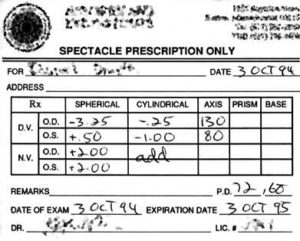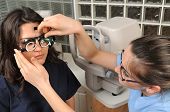How to read eye prescription – Basics explained, Abbreviations and terms used, decoding a sample eye prescription, Visit your eye doctor regularly, Watch a video by Specsavers, Contact lens prescriptions and glasses prescriptions, Eye test at Boots Opticians, 2 important vitamins for good eye health
How to read eye prescription and understand it in simple terms !
The Basics:
An eyeglass prescription is an order written by an eyewear prescriber, such as an optometrist or ophthalmologist, that specifies the value of all parameters the prescriber has deemed necessary to construct and/or dispense corrective lenses appropriate for a patient. If an examination indicates that corrective lenses are appropriate, the prescriber generally provides the patient with an eyewear prescription at the conclusion of the exam.
The parameters specified on spectacle prescriptions vary, but typically include the patient’s name, power of the lenses, any prism to be included, the pupillary distance, expiration date, and the prescriber’s signature. The prescription is typically determined during a refraction, using a phoropter and asking the patient which of two lenses is better, or by automated refractor, or through the technique of retinoscopy. A dispensing optician will take a prescription written by an optometrist or ophthalmologist and order and/or assemble the frames and lenses to then be dispensed and sold to the patient.
Abbreviations and terms used in eye prescriptions:
Similar to medical prescriptions, eyeglass prescriptions are written on paper pads or included in a patient’s electronic health record, and contain a number of different abbreviations and terms:
Oculus means eye. Nearsightedness/short-sightedness refers to myopia and Farsightedness/long-sightedness refers to hyperopia.
O.D.: oculus dexter (right eye)
O.S.: oculus sinister (left eye)
O.U.: oculus uterque (both eyes)
CYL: cylindrical correction, which is used to identify an astigmatism
AXIS: direction of an astigmatism correction
DV: distance vision, or the part of your prescription to help you see things far away
NV: near vision, or the part of your prescription to help you see things close-up
ADD: additional power measurement for bifocal and multifocal lenses
Further explanation:
For each eye, the first number you’ll see after O.D., O.S., or O.U. is a spherical correction (SPH), measured in diopters. This number is used to identify how strong your lenses need to be to correct your vision.
If the number has a minus (-) sign next to it, it means you’re nearsighted. A plus (+) sign or no sign means you’re farsighted. A higher number, regardless of whether there is a plus or minus sign, means you’ll need a stronger prescription.
Similarly to the SPH, there will also be a number with a plus sign (for farsightedness) or a minus sign (for nearsightedness) that follows CYL. A higher number means that you have a more severe astigmatism.
How to read eye prescription – Watch a video by Specsavers
Visit your eye doctor regularly:
Your vision prescription can change over time. It’s important to get regular eye checkups so your glasses and contact prescription stays up to date. Your eye doctor can also check for common eye conditions that may require additional treatment or correction. If your vision changes or you’re having trouble seeing clearly, make an appointment to get your eyes checked and let your doctor know your symptoms.
Adults ages 19 to 40 with vision problems should get their eyes checked at least every two years. Adults older than 40 should get them checked once a year. If you’re an adult with no vision problems, get your eyes checked every five years until age 30, and then at least every 2 to 4 years from age 40 to 65. After age 65, you’ll need regular eye exams at least every two years.
Contact lens prescriptions and glasses prescriptions
A prescription for glasses is not the same as a prescription for contact lenses. That’s because glasses are positioned about 12 millimeters (mm) from your eyes, whereas contact lenses go directly on the surface of your eyes. Both prescriptions will contain corrections for nearsightedness, farsightedness, and, if needed, astigmatism. A contact prescription will also include the following additional information:
Base curve – This is the curve of the inside of your contact lens. It’s usually between 8 and 10, and matches the curvature of your eye.
Diameter – This is the measurement from edge to edge of contact lenses, and is usually between 13 and 15 mm, depending on the size of your eye.
Lens brand or material – Your doctor may recommend a specific brand or type of contacts.
Expiration date – A contact prescription is usually only good for one to two years after it has been issued. After this date, you’ll need another vision test and new prescription to buy more contacts.
Eye test at Boots Opticians
You can make an eye test appointment at Boots Opticians. Your appointment will usually begin with some preliminary checks:
They may carry out an eye pressure check by blowing a puff of air into your eye, or a visual field test where you monitor flashing lights across a screen. These quick and painless checks help identify the early signs of glaucoma.
They’ll take a digital retinal photograph to create a permanent record of your eye health. This allows them to monitor changes which may take place over time.
To help them make the best recommendation for your visual needs, they’ll ask a few questions about your lifestyle, such as how often you use computer screens.
2 important vitamins for good eye health
Vitamin A
Vitamin A deficiency is one of the most common causes of blindness in the world. This vitamin is essential for maintaining your eyes’ light-sensing cells, also known as photoreceptors. If you don’t consume enough vitamin A, you may experience night blindness, dry eyes, or even more serious conditions, depending on the severity of your deficiency.
Vitamin A is only found in animal-derived foods. The richest dietary sources include liver, egg yolks, and dairy products. However, you can also get vitamin A from antioxidant plant compounds called provitamin A carotenoids, found in high amounts in some fruits and vegetables.
Vitamin C
Your eyes require high amounts of antioxidants — more so than many other organs. The antioxidant vitamin C appears to be especially important, although controlled studies on its role in eye health are lacking. The concentration of vitamin C is higher in the aqueous humor of the eye than in any other body fluid. The aqueous humor is the liquid that fills the outermost part of your eye.
The levels of vitamin C in the aqueous humor are directly proportional to its dietary intake. In other words, you can increase its concentration by taking supplements or eating foods rich in vitamin C. Observational studies show that people with cataracts tend to have a low antioxidant status. They also indicate that people who take vitamin C supplements are less likely to get cataracts.
ALSO REFER
Long term health care life insurance policies
Electronic Components manufacturers in the USA
Pest Control companies in California
London to New York by Luxury ship
Cloud storage providers for business
Commercial fire alarm system companies
Market research companies in California
Scholarships for college students in Wisconsin

